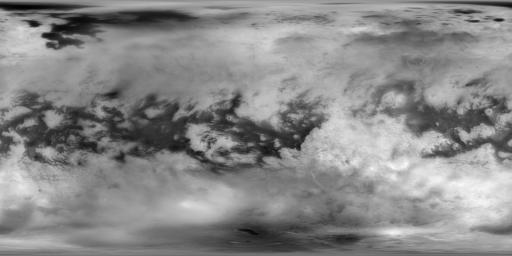This Cassini Imaging Science Subsystem (ISS) global mosaic of Titan's surface brightness in the near-infrared at 938 nm wavelength shows the distribution of Titan's wide variety of landforms, from the vast equatorial sand seas to the high-latitude lakes and seas of liquid hydrocarbons.
To generate this mosaic, 9,873 separate ISS images taken over more than 13 years of NASA's Cassini spacecraft operations at Saturn have been combined. Averaging such a large number of images dramatically improves how well surface features can be seen. A new photometric analysis method, with more accurate radiative transfer models of Titan's haze, allows spatial and temporal atmospheric and instrumental variations to be accounted for. This technique makes it possible to generate a mosaic without image seams that provides calibrated normal albedos. The image scale is 16 pixels per degree or 2.8 km in latitude.
The new image is an update to the previous version of the ISS imaging map of Titan. The most recent version was published in 2015.
2015:
https://photojournal.jpl.nasa.gov/catalog/PIA19658
2011:
https://photojournal.jpl.nasa.gov/catalog/PIA14908 2009:
https://photojournal.jpl.nasa.gov/catalog/PIA111492007:
https://photojournal.jpl.nasa.gov/catalog/PIA08399 2006:
https://photojournal.jpl.nasa.gov/catalog/PIA083462005:
https://photojournal.jpl.nasa.gov/catalog/PIA06201 2004:
https://photojournal.jpl.nasa.gov/catalog/PIA06086The Cassini mission is a cooperative project of NASA, ESA (the European Space Agency) and the Italian Space Agency. The Jet Propulsion Laboratory, a division of Caltech in Pasadena, manages the mission for NASA's Science Mission Directorate, Washington. The Cassini orbiter and its two onboard cameras were designed, developed and assembled at JPL.
For more information about the Cassini-Huygens mission visit http://saturn.jpl.nasa.gov and http://www.nasa.gov/cassini. The Cassini imaging team homepage is at http://ciclops.org.

 Planetary Data System
Planetary Data System












